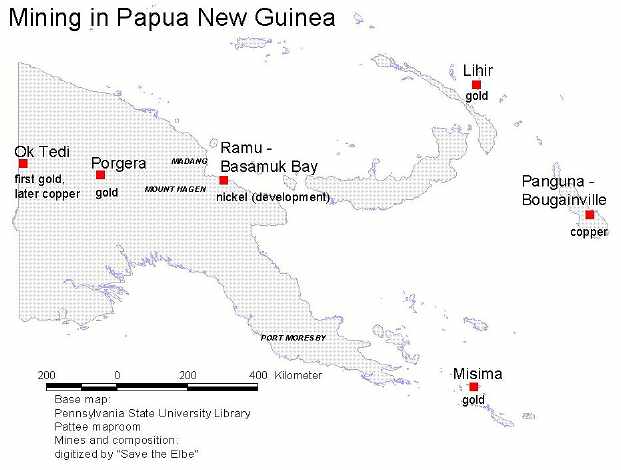Mining on Newguinea
New Guinea is located on the northern fringe of the Australian continental
plate. Where this collides with the Pacific bottom plate, the central mountain
spine folded up. The Pacific plate is pressed beneath the Australian. Down
in the subduction zone, the Pacific crust is molten. This does not happen
uniformly, so huge "drops" of magma rise from the melting zone. If they
come close enough to the surface, this will result in volcanic action.
Around the magma ovens, deep aquifers are heated under high pressure. Even
heavy metal salts are dissolved under these conditions. Through cracks
and capillaries, the solution moves up, and the salts precipitate when
they intrude cooler rock laying above. Thus ore deposits formed, and still
do, on Newguinea. On Lihir island, gold is mined from a volcano's caldera,
that is still warm.

Important mining operations in Papua New Guinea
The bronze age, the iron age, the idea of metals at all, did not reach
the Australian continent and the Pacific islands, till they were introduced
by European discoverers and colonists. The idea of mining, however, must
have been quite familiar to Papuans. Stones suitable for tools are not
simply picked from the ground. Harrer describes the method to recover proper
stones at a quarry by the Dani people. The Dani live west of the Star Mountains,
at Harrer's time a Dutch colony. A rock was heated by fire at its weak
point, for several days, if necessary. Then it was shock-cooled with water,
that inner tensions split it to pieces of convenient size, to be shaped
to adze blades, knives, or arrow heads. Before gunpowder blasting was introduced
400 years ago, the same method was applied in European mining.
Under German colonial rule, geologists ventured far upstream the Sepik
River in search for minerals. Two world wars interrupted such activities
of German and other parties, except some gold washing in the 30ies. When
the Japanese attacked New Guinea, defence by the UK and USA already had
in mind, to protect this treasure chamber. In the Cold War, that followed,
it was looked at as a strategic reserve.
Panguna Mine on Bougainville was the first large mining operation after
the war. Rio Tinto, the big international mining company, did wrong whatever
could be done wrong. They did not pay compensations to local landowners.
The working force was hired from abroad, a colonial practice, that always
raised serious conflicts. The project had been permitted generously by
the Australian colonial administration. The tremendous amount of waste
that is always connected to copper mining, was dumped into a river and
the sea without treatment, which stopped gardening (the traditional method
of agriculture on New Guinea) and fisheries in the affected area. Rumours
among Bougainvilleans grew to a civil war, that led to the closure of the
mine in 1989. The Hamburgian copper-smelter NA was one of the customers
of Panguna ore, but they found a substitute just in time: Ok Tedi.
The copper and gold deposit of Mount Fubilan on the Upper Ok Tedi was
discovered by Kennecott, a US company. But Kennecott withdrew its claim,
when negotiations with the independent government of PNG failed, that was
determined to do a better bargain than the colonial administration. Broken
Hill Proprietary (BHP) from Australia and its consorts took over and founded
Ok Tedi Mining Limited (OTML), because they estimated the ore reserves
three times higher, than Kennecott did recognize, and the gold price went
up that time. BHP avoided many of the mistakes made on Bougainville, but
environmental damage turned out the same, though the PNG government had
imposed to OTML, to build a dam south of the mine, to retain the tailings.
Ok Tedi was the reason, to establish a Mining Act (Ok Tedi Agreement).
It was the first exercise of environmental legislation of PNG, it was once
regarded as cornerstone of economic development, and it is the first regular
model, how to close a mine after exploitation. Anything that happens at
Ok Tedi will set a precedent for other mining projects. If OTML is forced
to dispose tailings on land safely, any company will have to do it. The
term "rehabilitation" will be defined in the mine closure plan for Ok Tedi
mine. Other countries, where mines operate under tropical conditions, will
look at PNG.
Original issue April 2001
last update February 2003
 Index of Ok Tedi Pages
Index of Ok Tedi Pages
 Homepage
"Save the Elbe" Homepage
"Save the Elbe"
|




 rettet-die-elbe.de
rettet-die-elbe.de
